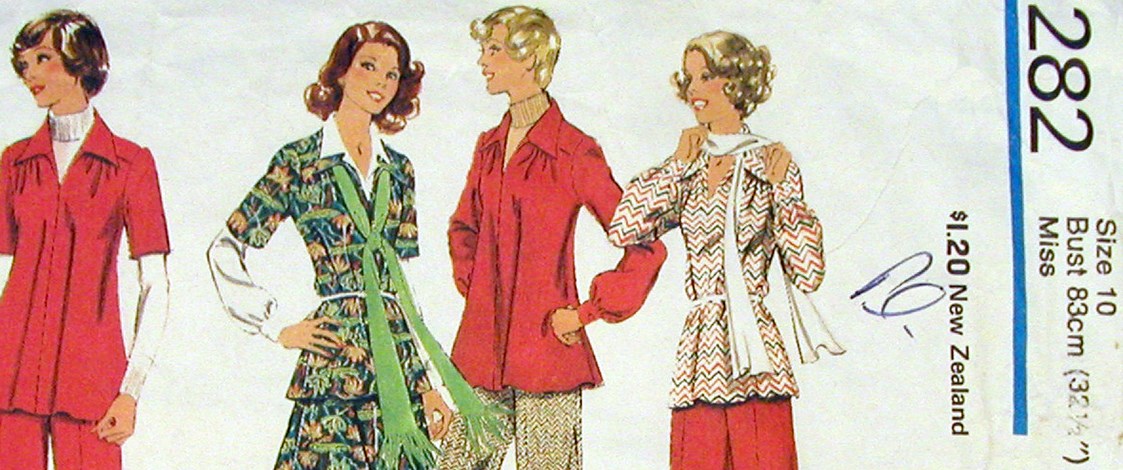Stories
Home Sewing in New Zealand

For most New Zealand designers their passion for fabric and fashion started at home. It was a mother or grandmother who taught them to sew clothes for their dolls or a dress for themselves and it was at home that they learnt the skills necessary to create a unique and individual wardrobe.
Home sewing has always been a way to achieve what you could not buy, whether you were constrained by cost or availability the solution was the same – DIY, and in New Zealand we did in huge numbers.
The pioneer women of New Zealand made everyday clothing for the family themselves - the underwear, shirts and day dresses. Only the ‘best clothes’, the formal dresses and the men's suits, were made by professional tailors and seamstresses. Fashion information arrived via illustrations in the women's pages of the daily newspapers and through regular correspondence with friends and family who lived nearer the fashion capitals of London and Paris. While the well-to-do could keep abreast of fashion and had more occasion for 'best' their cast-offs trickled down to the less well off and were remodelled and repurposed giving these cast off garments an extension to their useful life.
Even when dresses started to be readily available 'off the peg' in department stores and in urban dress shops such as The Elite owned by Josephine McGuire in Nelson in the 1920s, home sewing remained the primary source of a woman's wardrobe. The fabric, and notions section of Smith & Caughey's occupied prime daylit space on the ground floor while you had to go to the first floor to get to the women's ready to wear section.

The fabric and notions department in Smith & Caughey's, 1923.
While sewing skills were primarily passed on at home with mothers teaching daughters, there were also training schools where you could refine your techniques and also learn pattern making to become a qualified dressmaker. Druleigh College was one of these and trained many of the young women who went on to work for fashion manufacturers like El Jay and later, as married women with families, could supplemented their incomes through dressmaking. According to Douglas Lloyd Jenkins in The Dress Circle, "It is a defining characteristic of mid century New Zealand that most women could sew and large numbers did so very skilfully".
The range of sources for the latest fashion information became more diverse. Newspapers had their own 'fashion correspondents' in London and Paris who wrote columns for the women's pages, Hollywood fashion style arrived via the movies and 'star' gossip magazines like Movie Mirror and True Story. Newspapers and magazines regularly published photos of garments shown in department store fashion parades. In October 1947, 50 garments from the latest Paris Spring-Summer couture collections were shown at a fashion parade at Milne & Choyce. The garments were shown in the Women's Weekly, alongside detailed descriptions of the construction details and tips for the home dressmaker.
Most sewers however were not skilled enough to replicate a garment simply from a pictures and the most powerful fashion tool available to them was the commercial dress pattern. In the 1930s the Women's Weekly started a free pattern service for it readers so that they could keep up with the latest trends. While Druleigh, Academy and McCalls were among the names on the patterns at this time one that has stood the test of time and survived into the contemporary era is Butterick.
Winifred McGreal made a two-piece suit from an Academy pattern in 1962.
Fashion in the first half of the century was largely described in terms of elegance and sophistication, an aesthetic attune to the mature woman but in the 1960s the 'youthquake' changed all that. Fashion and music were taken over by the young and chic was replaced by cool. Mary Quant and Betsey Johnson defined the look which was simple, short and fun. Home sewing engaged a whole new following with teenagers who were keen to have the newest fashions and were able to make them because the shapes were so simple. For the cost of a two yards of fabric and a few hours to 'run up' a frock on a Saturday morning, a young woman could hit the clubs in the evening looking every inch the groovy miss, the equal of her London or New York counterpart.
Home sewing made fashion fast and affordable and brought on an new generation with the skills to turn ideas into wearable reality. The 1970s hippy era with its op shop aesthetic and its ethos of self sufficiency served to further embed and expand these stitching skills.

Influenced by the 'Abba era', Trish Murphy made these floral culottes and lace waistcoat to wear dancing.
It is these two decades that gave rise to the nascent talent that was to become the New Zealand fashion design industry which blossomed in the 1980s and continues today. For Annie Bonza, Marilyn Sainty, Liz Findlay, Doris de Pont and their cohort it was their sewing skills that allowed them to make what they could not buy. They were able to defy the constraints of budget and mainstream taste and could create garments that were uniquely their own. Today globalisation has made every fashion item imaginable, no matter where in the world, available via the internet. On the High Street, the fashion offering is identical in London, Paris, New York and Auckland. In response there is a new generation looking for a way to make something that is personal, hand made and individual and they are discovering the creative freedom inherent in an ability to sew.
Text by Doris de Pont. Banner image © Auckland Museum CC BY.
Last published September 2013.